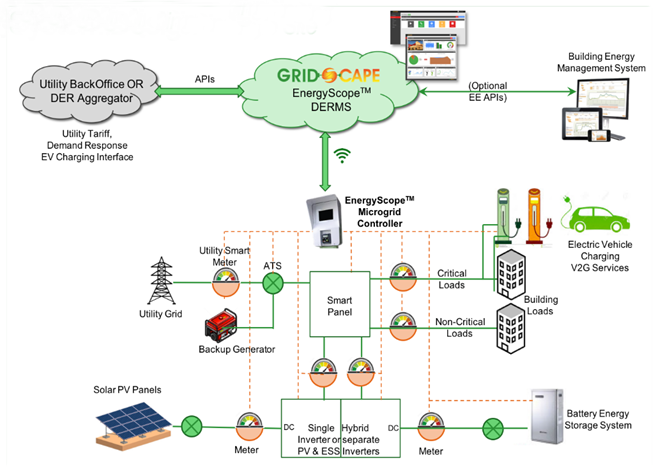Continuing the Imperial Western Products legacy of environmental stewardship with microgrids from Gridscape.
Case study – Imperial Western Products
Imperial Western Products, established in Coachella, CA in 1966, has grown by leaps and bounds to become a very successful, broadly diversified corporation.
Imperial Western Products is setting the industry standard for proactive environmental protection and conservation.
Gridscape is working with IWP and helping them with their green endeavours.
“As a long time recipient and supporter of several CEC grants, we are extremely excited to be a microgrid technology and solution provider to IWP and help IWP with increased energy reliability and reduction of GHG emissions,”
– Vipul Gore, CEO, Gridscape Solutions.
About the California Energy Commission:
CEC is the state’s primary energy policy and planning agency. Created by the Legislature in 1974; its responsibilities include forecasting energy needs, promoting energy efficiency, supporting the renewable energy market etc. Within the last two years, the most important development in California’s energy policy has been two landmark pieces of legislation for energy policy that focus on climate change and transportation.

Why local sustainable power plants make sense for IWP?
Imperial Western Products transforms materials such as agricultural organic byproducts, bakery byproducts, and used cooking oil into animal feed, preventing nearly 700,000 tons of organic material from entering landfills each year.
The installation of this cutting edge project will help Imperial Western Products’ Coachella facility to reduce its total grid energy usage by more than 35 percent, reducing its GHG emissions by over one-third. The microgrid will also increase reliability by allowing the facility to continue operations during a utility blackout.
Benefits from the local sustainable power plant (microgrid):
- Savings: Process oriented industries like Imperial Western Products are always in need for clean and continuous power. These companies face huge loss in productivity, mostly and equipment failure due to power cuts and variability in frequency and voltage. As the bills of such industries tend to be quite high this project would help in cost savings and also have marketing benefits.
- Lowering GHG emissions footprint: Such industries need to be a good citizen of the community because they usually have a high GHG emission footprint. The microgrid can reduce the GHG emissions by one-third.
- Microgrids Provide Financial, Resilience, and Social Benefits.

The Project
IWP signed a contract with Gridscape for the installation of a PV system and microgrid. Gridscape will be installing 847 kW of PV (rooftop and carports and 1300 kWh microgrid at their facility to minimize the utility consumption and maximize the financial and environmental benefits. As of now, the design has been submitted for the City approval.
- The project will save approx. $174,305 in energy costs annually.
- The project will also offset 595 MT of GHG annually.
- The project will reduce the peak demand and will contribute to additional cost savings.
Design
The project will be based on following figure system integration architecture for Gridscape projects with minor modifications/ alterations.

Typical System Integration Architecture
Below is a single line drawing for one of the sites.

Microgrid Project Layout
About Gridscape:
Gridscape is the largest and a well-established name specializing in developing and deploying standards-compliant future-proof products and solutions for renewable energy microgrids and fleet charging. Intended to serve as a locally produced sustainable power plant, these microgrids allow sites to become less reliant on the grid by using local sources of energy. They can provide as much as 90% independence from the grid energy, and thus reduce overall energy cost & provide backup clean emergency power during PSPS or other power disruption events. Gridscape with its ‘Product Centric’ approach to microgrids integrated with fleet EV charging solutions allows for lower cost of installation and reduces the time for deployment by substantially lowering integration issues. It expects to deploy and operate over 35 microgrids in California public and commercial facilities over the next 12 months.
Unlike traditional microgrid developers, Gridscape employs a holistic product-centric, artificial intelligence (AI) based software-driven approach to designing, deploying, and managing microgrids. It also integrates Electric Vehicle (EV) charging and other controllable loads into its solution. Through its broad partnerships with various Tier 1 and Tier 2 financiers, design engineering firms, energy storage manufacturers and other renewable energy product providers, it leverages the best-in-class mix of technology and finance to provide maximum return on investment to customers.
Gridscape’s solution is unique, and it differentiates from traditional systems in following manner.
Product Centric Approach (vs Project Centric Methodology) for scalability, maintainability, and longevity of microgrid assets
Software driven architecture resulting into no technology obsolescence and ability to adapt to changing PG&E tariffs and distribution grid conditions.
Dynamically configurable with an ability to change the microgrid operational modes on demand
Energy Information System: A cloud-based distributed energy resource management system (DERMS) that includes
1
Smart AI-based energy management and optimized load and generation dispatch; and
2
Very powerful visualization dashboard for accessing real time and historical data about PV, Storage and EV charging stations.
Inherently Integrated with EV charging infrastructure
Full Energy Management including demand charge reduction, TOU arbitrage, grid services.
Integration with various Cloud platforms such as Google, Amazon for grid services and load management.
Gridscape EnergyScopeTM Dashboards

